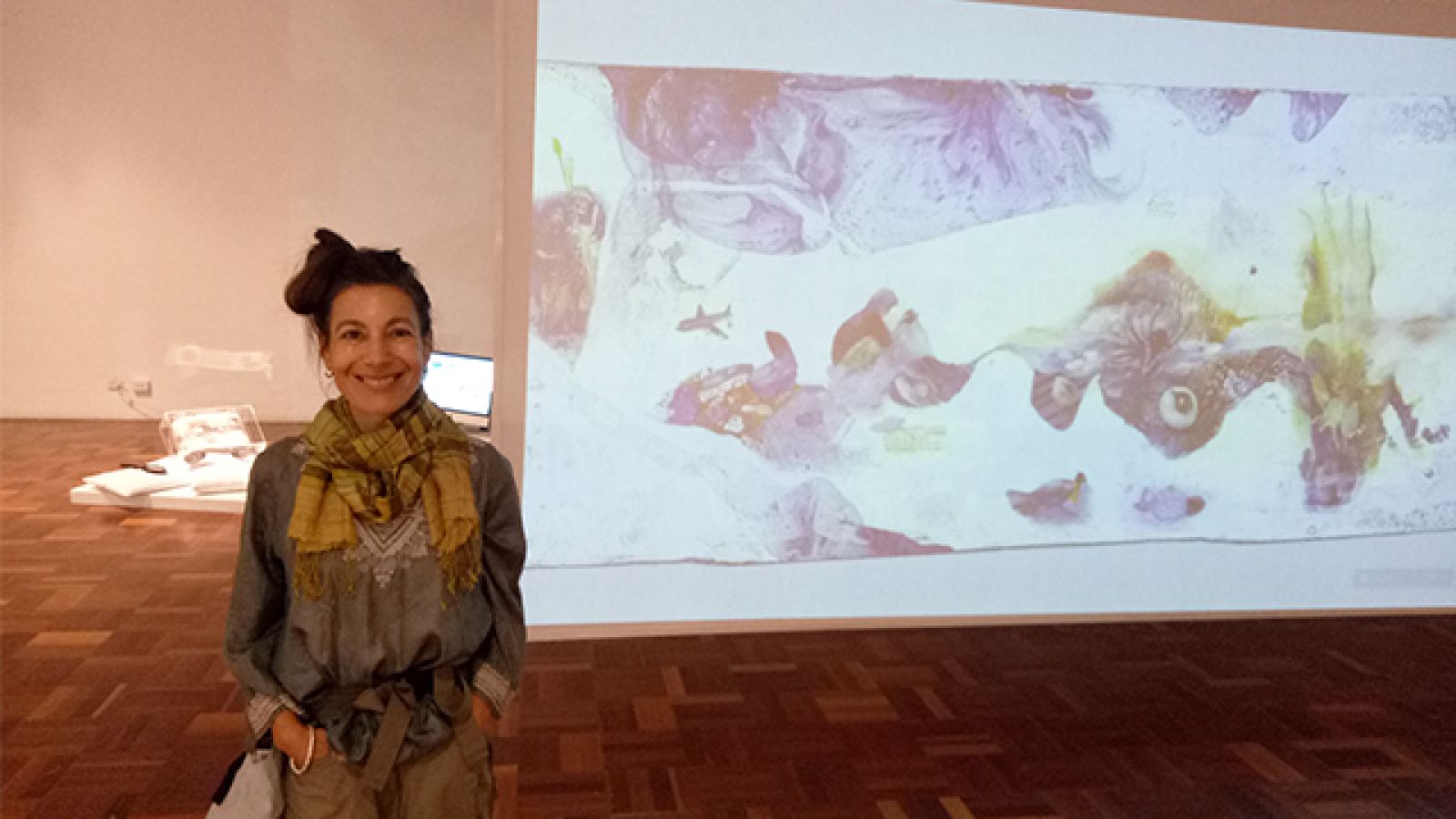Nomadic journey inspires ANU artist

Michal Glikson with a projection of part of her work.
Many artists go to great and unusual lengths to create their masterpieces. School of Art and Design Doctoral candidate Michal Glikson became a nomad.
For two and a half years, she travelled – first around Canberra, and then through India and Pakistan.
“Nomadic practices are immersive practices whereby knowledge and understanding of the world is gained through wandering,” Michal explains.
For her overseas journeys, she carried her materials with her, working on long scrolls of paper on which she painted miniature forms. Miniature, Michal says, allowed her to create portraits of the extra/ordinary people she met and the stories she learned in ways that parallel ancient Persian miniature paintings.
“I chose the scroll because scrolls are very portable,” she says.
“And the scroll has a lovely resonance about it as an ancient vessel of knowledge and information transference, as well as being a well-known story format in Indian visual culture.”
Her Australind scroll, documenting her journey through India, spans 10.2 metres.
“I thought my entire research journey would fit onto that size – but it didn't,” Michal says.
“As I crossed the Wagah/Atari border, my paper ran out. I began a new scroll in Lahore, and thus the stories of India and Pakistan are separated.”
Michal was interested in stories of not belonging and homelessness. Throughout her research she met many people who had no physical homes, others who felt “unhomed”, and people who had a place to live, but who had little autonomy or control over their lives in that place.
She was also interested in people’s workplaces, what she describes as the “home of the worker”.
“I met many workers in India and Pakistan who live, eat and sleep in their workplace. Sometimes they are able to go home on a Sunday. But many work seven days a week for months on end.
“So their workplace is their ‘home’. Encountering such people, painting became for me a way of asking about their life, and meditating on their humanity as well as thinking about these workplaces and their often unsafe/challenging conditions.”
One home/workplace Michal explored was the residence of a friend she stayed with for a few months in India. She observed and filmed their domestic maid, fourteen year old Bulbuli.
“I became very interested in Bulbuli’s working day, because it was a very long and hard working day and because her age meant that she found it difficult to assert herself in negotiating her work conditions” Michal says.
Bulbuli would arrive at the home by 6:30am, often not leaving before 8pm. She worked seven days a week.
“She was in a situation common for domestic workers in India, whereby most of her daily life is spent at work.
But the workplace was not her home in the sense that she had no room there, or place to rest, and was on her feet for most of the day.”
Michal’s short film about Bulbuli is embedded in an interactive virtual tour featuring the digital versions of her three scrolls. By clicking on Bulbuli’s image in the Australind scroll, we are taken into an observational film of Bulbuli. We see the gate to the residence, Bulbuli’s embroidered gown, closely-framed shots of Bulbuli’s cooking.
Michal says that her attraction to the miniature corresponds to the way that she is drawn to the details of people’s lives and conditions, as evident in her paintings and her films.
“Besides contextualising the paintings, the films I have made also often reveal how my eye as a painter explores the world and my subject.
“The idea of bringing documentary film into my project has also been about opening a window for my viewer onto the environments and conditions in which I produce this work.”
The idea to paint while negotiating the experience of crossing cultures was very important to Michal, in researching and producing these artworks. Making the scrolls has been about recording and processing the impact of crossing cultures. Negotiating her experiences of very divergent ways of being, Michal says, was relieved through painting.
“I fell really ill in Bengal three times and had to be hospitalised,” she says.
“With an outlet of expression in the diary-like scroll, I was able to process the experience of helplessness.
“I was also more motivated to heal and to get back out in the world rather than succumb to the temptation to stay indoors lying down.”
Michal says that having the ability to express yourself through creative means is hugely important, especially now when we’re seeing huge diasporas occurring.
“There are so many people who are on the move, who are dealing with extremes of insecurity in a constant way. How can they deal with it?
“Whether you're a peripatetic practitioner and you're choosing to be with and understand the peripatetic, or you're peripatetic because the world has forced you out of your home, it can be very important to develop tools that help you negotiate and process challenging experiences of being without a permanent base.”
The Australindopak Archive is the interactive virtual tour featuring the digitised versions of Michal Glikson’s 10.2 metre Australind scroll, 10.5 metre Indopak scroll, and 3 metre Canberra and other ideas scroll, together with her 40 documentary field films, and 70 field-generated sound compositions can be viewed at michalglikson.com. Her scrolls and the interactive virtual tour are on display at the ANU School of Art and Design main gallery until 11 March.